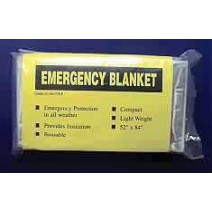 emergency space blanket[/caption]
emergency space blanket[/caption]
School started today and one of the things my kids were asked to bring was an emergency blanket in an emergency kit. This made me wonder where they came from. Emergency blankets were originally developed by NASA in 1964 for the U.S. space program. They would protect the astronauts from the extreme conditions on the moon. Emergency blankets (also known as space blankets, thermal blankets, first-aid blankets, or mylar blankets) are a low-weight, low-bulk blanket made of heat-reflective thin plastic sheeting. They can be used in many emergencies, for first-aid, and in survival kits because they are windproof and waterproof. They are often given to marathoners or other endurance racers before or after they race. They can also be used for watching or participating in winter sports. For first-aid they can be used to prevent or counter hypothermia and to cover injured victims to help reduce shock. Because they are lightweight, outdoor enthusiasts like to carry them. They provide protection from the elements with a unique combination of aluminum metal vapor and polyester film. They will reflect and retain up to 80% of your body’s radiant heat. These have been recommended as one of the “top 10 necessary products” for inclusion in all outdoor survival and first aid kits by safety agencies and wilderness groups around the world. They can also be used as an emergency shelter and for sunshade protection. If a disaster occurred at home, school, or work you might need to use one for protection from the elements. Rainy Day Foods sells emergency blankets that are 52” x 84” and weigh about 2 ounces. You should consider keeping some in your 72 hour kit, camping gear, and in all vehicles including: cars, trucks, boats, 4-wheelers, and snowmobiles. Because of their many uses, I know I will be adding several more emergency blankets to our kits and vehicles.
Contributed by Pam Higley
